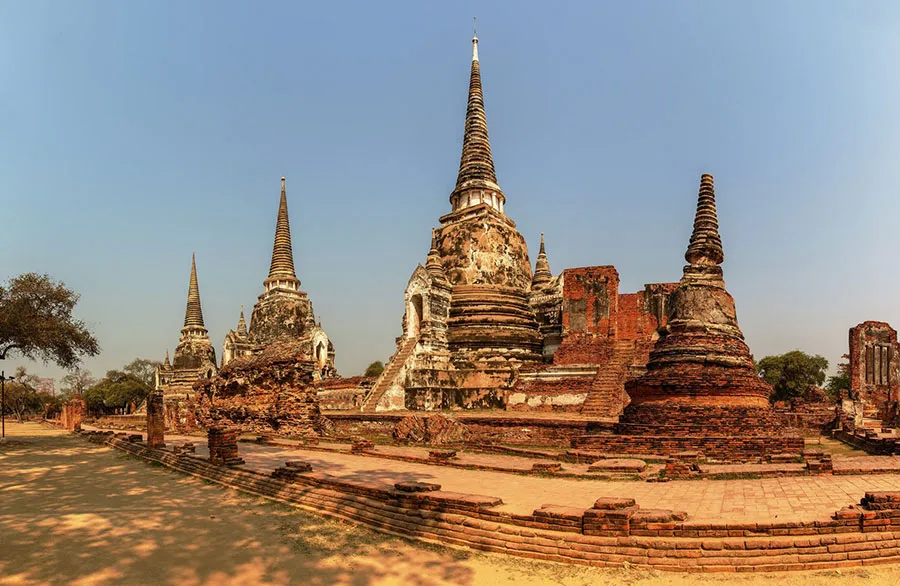Step into the heart of Thailand’s grand past and prepare to be dazzled by towering chedis, crumbling ruins, and the lingering whispers of a royal kingdom.
Once upon a time – specifically in the 14th century – Ayutthaya wasn’t just a city; it was a thriving Ayutthaya kingdom, a melting pot of culture, trade, and architectural marvels. At its core stood Wat Phra Si Sanphet, the most sacred and prestigious temple of the kingdom. Unlike other temples, this one had an exclusive guest list: only royalty and high-ranking officials were allowed in. No monks, no commoners – just kings, golden Buddha images, and centuries of spiritual grandeur. Today, this temple remains an essential highlight of Ayutthaya Historical Park, drawing visitors from all over the world to witness its grandeur.
A Name as Majestic as Its Legacy
In Thai, it’s called วัดพระศรีสรรเพชญ์ (Wat Phra Si Sanphet), which translates to “Temple of the Holy, Splendid, and Omniscient Buddha.” Quite the mouthful, but it perfectly captures the grandeur of this sacred site. Built in 1448 within the royal palace grounds, it housed a stunning 16-meter (52-foot) Buddha image covered in 340 kilograms (750 pounds) of gold. During the reign of King Ramathibodi, the temple reached its height of glory, serving as a model for future temple designs, including the Grand Palace in Bangkok.
Glory, Destruction, and Resilience of Wat Phra Si Sanphet
For centuries, Wat Phra Si Sanphet stood as a beacon of faith and power. It hosted royal ceremonies, served as a model for future temples, and symbolized the kingdom’s spiritual heart. Then, in 1767, Ayutthaya met its match when the Burmese invaded, leaving destruction in their wake. The golden Buddha image? Melted down. The temple? Reduced to hauntingly beautiful ruins. But even in its shattered state, the temple remains a powerful reminder of Thailand’s rich and resilient past. Today, it stands proudly in the UNESCO-listed Ayutthaya Historical Park, a designated World Heritage site preserving the remains of the once-magnificent Ayutthaya Kingdom.
Why Wat Phra Si Sanphet is a Must-See
So, why visit a centuries-old temple that’s seen better days? Because its story, architecture, and sheer presence make it one of Thailand’s most captivating historical sites. Here’s what makes it special:
The Iconic Three Chedis – These towering stupas, standing proudly despite time’s wear, house the ashes of Ayutthayan kings.
A Blueprint for Greatness – Ever visited the Grand Palace in Bangkok? Its layout was inspired by Wat Phra Si Sanphet.
Timeless Beauty – Weathered bricks, remnants of sacred Buddha images, and the serene energy of the ruins make this a paradise for history lovers and photographers alike.
A Royal Sanctuary – Unlike other temples, this was strictly a royal sanctuary, emphasizing its deep connection to the reign of kings in the Ayutthaya Kingdom.
Hidden Gems & Fun Facts
The temple’s golden Buddha image was one of the largest in Thailand before it was looted and melted down. Unlike most Thai temples, monks never lived here—this was strictly a royal sanctuary. Ayutthaya was once wealthier than London or Paris, attracting merchants from as far as Europe and Japan. Bricks from Wat Phra Si Sanphet were later used to build Bangkok’s Wat Phra Kaew, home to the revered Emerald Buddha. The temple is part of the UNESCO-listed Ayutthaya Historical Park, a treasure trove of ancient wonders and a recognized World Heritage site.
Q&A: All You Need to Know
What makes Wat Phra Si Sanphet special?
It was Ayutthaya’s most important temple, reserved exclusively for royalty. Today, its breathtaking chedis stand as symbols of a lost kingdom and the grandeur of the Ayutthaya Historical Park.
Can I still see the golden Buddha image?
Sadly, no. The Burmese melted it down in 1767, but a stunning replica can be found at Wat Phra Mangkhon Bophit, right next door.
Is Ayutthaya worth visiting just for this temple?
Absolutely! But while you’re there, don’t miss the other jaw-dropping ruins that make Ayutthaya Historical Park a UNESCO World Heritage treasure.
What should I wear when visiting?
Dress modestly (cover shoulders and knees) to show respect for Thailand’s cultural heritage.
What’s the best way to explore Ayutthaya Historical Park?
Bicycle, tuk-tuk, or a guided tour. If you’re in the mood for something extra special, take a sunset boat ride around the historic island.
Wat Phra Si Sanphet is more than just a collection of ancient bricks – it’s a portal into Thailand’s golden age. Whether you’re a history enthusiast, an architecture lover, or simply someone seeking a connection to the past, this temple will leave you spellbound. The royal palace and temple complex offer a rare glimpse into the grand architectural vision of the Ayutthaya Kingdom. The historical park itself is a sprawling wonderland filled with sacred Buddha images, remnants of the Grand Palace, and relics from the reign of King Ramathibodi. So pack your camera, lace up your walking shoes, and prepare to be transported to a time of kings, splendor, and timeless wonder.
Read more at Ayutthaya official page.

Lovely website! I am loving it!! Will come back again. I am bookmarking your feeds also
Do you mind if I quote a couple of your articles as long as I provide credit and sources back to your site? My website is in the exact same area of interest as yours and my visitors would genuinely benefit from a lot of the information you present here. Please let me know if this okay with you. Thanks!
Hello, and thank you for this question. Of course, as long as you provide the credit and link back to the original article, it is OK